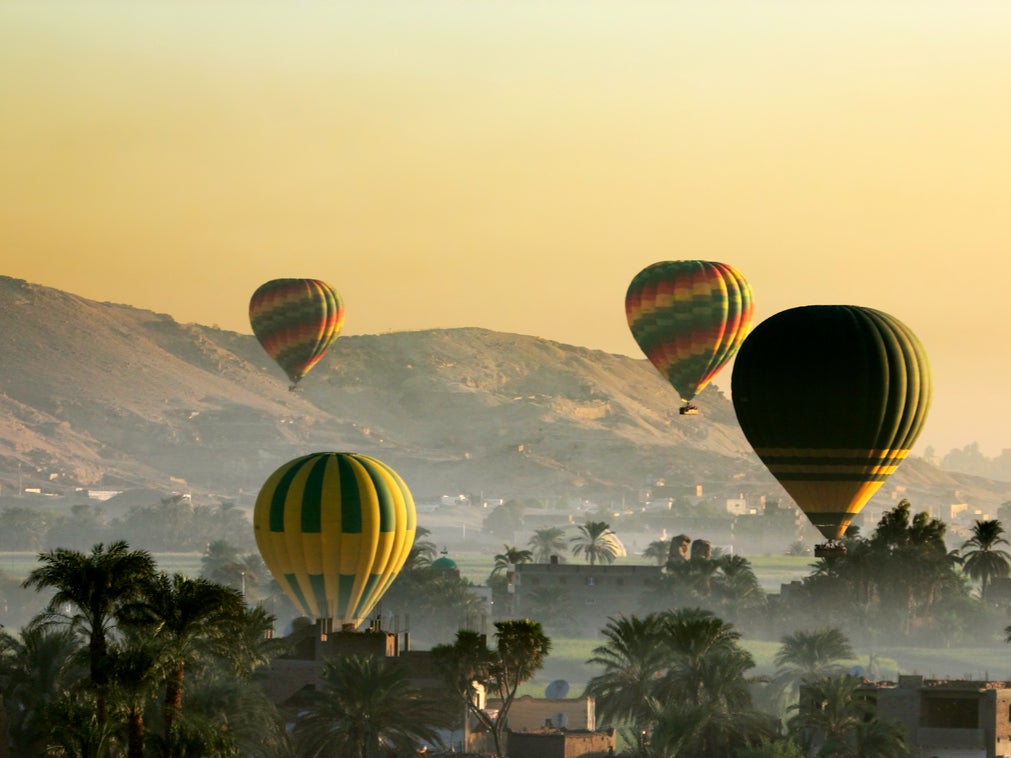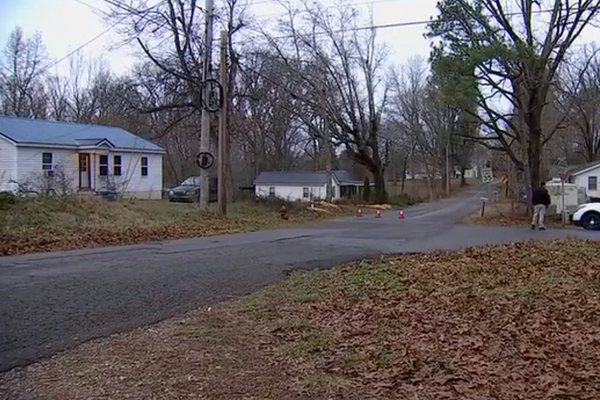
Trade Red Sea resorts for a historic holiday to majestic temples and pharaoh tombs in Egypt’s eastern city.
Lapping the banks of the crocodile-peppered Nile, Luxor, once Egypt’s ancient capital Thebes, fuses a rich variety of the old and the new – the east and west banks divided by Africa’s longest river.
Cosmopolitan Cairo may have the pyramids, but Luxor, a designated World Heritage site since 1979, is not without its own historic institutions, buzzing souks and Nile cruises.
With a host of visible history in archaeological sites, preserved artefacts and Theban necropolis, the city is known as one of the world’s “greatest open-air museums” for good reason.
From embracing Bedouin cuisine to the grandeur of the Winter Palace and reaching new heights on hot air balloon rides, fill your time in this Unesco hotspot by embracing the past on a sun-soaked cultural break.
Read more: Why Egypt’s Sharm el-Sheikh is the ultimate winter sun holiday
Tour the Valley of the Kings

Two dry river valleys, split into an east and west bank much like Luxor city, form an ancient burial ground for excavated tombs of the nobles of the New Kingdom. In the east, carved deep into limestone rocks to deter tomb raiders, the Valley of the Kings sits under the Al Qurn Mountain. The valley is the resting place of over 60 ancient Egyptian tombs, including the tomb of young king Tutankhamun discovered in 1922. From around 1550 BC the pharaohs, nobles and royals from 18th to 20th century dynasties were buried here with their possessions in preparation for the afterlife.
The world-renowned archaeological site is a highlight of a Luxor holiday, with a ticketed visitor centre and a limited number of tombs open to the public at any time to control potential damage.
Visit Karnak Temple after dark

Built during the Middle Kingdom era, Karnak Temple comprises three compounds dedicated to the Theban triad: Amun, Mut and Khonsu. The colossal complex of pylons, chapels and shrines was developed over 1,000 years between the 12th and 20th dynasties on the east side of the Nile’s bank – a significant memorial to Egyptian cultural history and the work of dozens of pharaohs.
A nightly “Sound and Light Show” in 10 different languages illuminates evenings at the Unesco World Heritage-listed temple. The hour-long walking tour poetically narrates the history of the pharaohs while eerily enchanting lights dance over the impressive religious presentation.
Read more: This enclave is the perfect alternative to Egypt’s Red Sea resorts
Take a sunrise hot air balloon ride

Take to the skies for a bird’s-eye view of the archaeological museum of the West Bank at sunrise and join the sea of vibrant hot-air balloons that float over Luxor. See the Valley of the Kings, Valley of the Queens, Colossi of Memnon and the Nile River from a new perspective on a bucket-list ride.
A wealth of tour companies with expert pilots offer to take tourists to memorable new heights over ancient Thebes with a light breakfast and traditional tea served in the balloon basket as you voyage past ancient monuments and panoramic city views.
Sip drinks at the Winter Palace

Steeped in romance and history, Sofitel’s Winter Palace is the perfect spot to savour herbal tea or frosty pints in the late afternoon sun. The historic colonial-style hotel in the heart of Luxor – opened in 1907 – has hosted nobles and literary greats alike. The Nile view terrace is even the spot where Agatha Christie penned Death on the Nile.
Deep red walls, crystal chandeliers and the lull of a classical pianist in the opulent Royal Bar offers five-star luxury as an accompaniment to glasses of fine wine, champagne and cocktails. Outside, an oasis of leafy palms creates the Royal Gardens at the prestigious explorer’s hotspot.
Set sail on a felucca boat

Used to sail the Nile River since the time of the pharaohs, the white canvas sails of traditional wooden felucca boats offer a graceful passage to North Luxor’s Banana Island. Sailing by plentiful banana plantations and accompanied by fresh fruit, Egyptian mint tea and colonies of birds, short cruises crewed by local sailors are facilitated by the balmy Egyptian breeze.
En route home, relax on the comfortable cushioned deck and marvel at the romantic sunset over the West Bank, backdropped by sprawling farmlands and the gentle waves of Egypt’s most famous waterway.
Read more: Best things to do in Hurghada, Egypt
Haggle at El Souk

Pick up anything from keffiyeh scarves to Middle Eastern spices at El Souk street market near Luxor Temple. Weave your way through a labyrinth of leathers, relic replicas and statement Bedouin jewellery in the atmospheric centre, the lively tradesmen are happy to haggle – the ultimate Egyptian experience – for the best deal on handmade pottery, perfumes and carpets. The pedestrian market spans several streets, with hordes of popular cafes and wooden kiosks selling brass trays full of souvenirs for affordable prices.
Eat Bedouin-style

A fusion of communities and cuisines come together in Luxor, and the rich offerings of the Nile Valley farmlands are a fertile supplier for dishes such as mandi spiced meat. For a tantalising taste of the past, sample generous platters of Bedouin-inspired cuisine including imbakbaka tomato broth pasta and madfoon meat and rice. Dine with the locals in traditional khayamiya tents or at rooftop tables for two with Nile views and authentic restaurants such as Bedouin Island on the West Bank.
Traditionally, Bedouin cooking in underground earth ovens or on open fires was said to infuse flavours, a technique still used in some Egyptian street eats and delectable libbah bread. Habak mint tea washes down the hearty servings, primarily of meat and dairy, as you enjoy a lively Bedouin show of Tanoura dancing, poetry and woodwind folk music.
Marvel at the Colossi of Memnon

Two stone statues of Pharaoh Amenhotep III, standing guard in front of the ruins of his mortuary temple, welcome tourists to the West Bank of the Nile, once the site of the largest Theban temple. The Egyptian pharaoh ruled from 1386 to 1349 BC and the 15m high sandstone structures of Amenhotep III seated on a throne symbolise his reign over Egypt.
The larger-than-life acoustic wonders named to represent the Greek god Memnon, a Trojan War hero, carry Greek and Latin inscriptions and the popular tourist destination is said to sing, literally – the statues were rumoured by the Greeks and Romans to give off high-pitched melodic sounds at dawn.
Read more: A first look inside the world’s largest museum – and its 22 mummies
Explore the Mortuary Temple of Queen Hatshepsut

In the cliffs of Deir el-Bahari opposite Luxor city, the Mortuary Temple of Queen Hatshepsut is one of Luxor’s most iconic sights. A queen who became a – self-declared – pharaoh of 18th dynasty Egypt, Hatshepsut’s remarkable 15-year reign began in 1473BC.
Royal architect Senenmut oversaw the construction of the stately three-level architectural mirage where painted relics line the walls to preserve the legacy of her reign, immortalised in the temple’s Chapel of Anubis, god of embalming and the cemetery, and the Sanctuary of Amun, a king of the Egyptian gods.
Look around Luxor Temple

Known as the “Southern Sanctuary” in ancient Thebes, the Nubian sandstone Luxor Temple is one of the best-preserved to tour in Luxor. The World Heritage complex on the east bank built in approximately 1392BC is believed to be the site where pharaohs were crowned in the annual Festival of Opet celebrations, a ritual practice dedicated to the rejuvenation of kingship and rebirth during a pharaoh’s coronation ceremony.
It took hundreds of years for New Kingdom pharaohs including Amenhotep III, Ramses II and Tutankhamun to construct and expand the large peristyle courts – a great feat of ancient Egyptian architecture – halls, chambers and towering obelisks. An avenue of sphinxes once ran between the Karnak and Luxor temples, and the latter also lights up after dark.
Read more: The best things to do in Egypt







